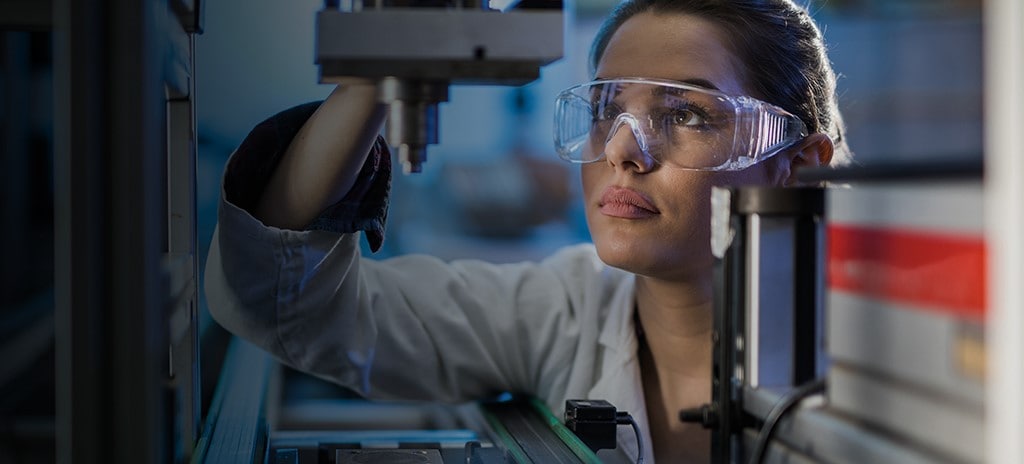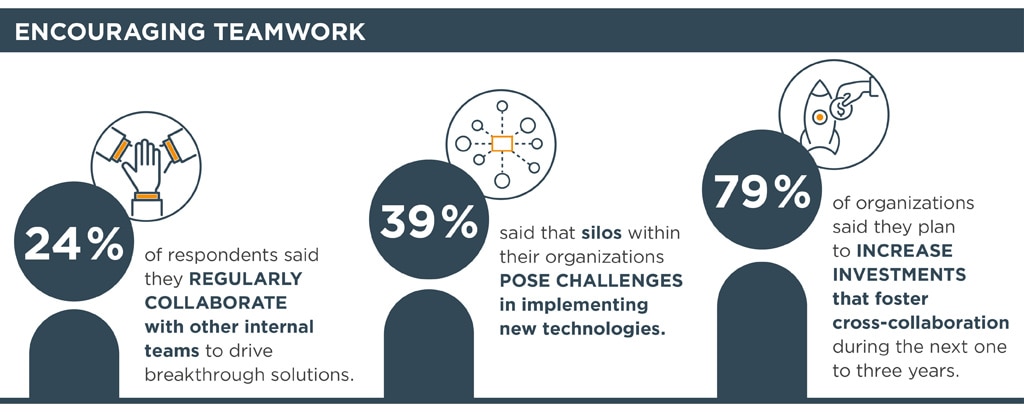
Innovation Insight
Solving the Innovation Talent Equation
Author: Malavika Sagar, Chief Human Resources Officer
With the rapid pace of change in the technology industry, developing a culture of continuous innovation is critical to an organization’s long-term success. So it’s no surprise that the vast majority of engineers and executives from around the globe cited innovation as their organization’s top priority in the TE Connectivity 2023 Industrial Technology Index, a global survey that examines the state of innovation within the industries shaping our world.
Ultimately, I believe that innovation is mainly driven by people — and organizations face essential questions about the best way to unlock the creative potential of their teams. Survey respondents cited several challenges and opportunities in their quest to increase innovation capacity, such as the need for additional training, the importance of collaboration, and finding external partnerships that supplement the skills and knowledge of existing teams.
These are all issues that TE Connectivity has faced as we’ve worked to establish a culture of innovation in our company. Below, we’re taking a closer look at several priorities that emerged from the survey results, offering insights from our own experience that can help organizations develop innovation talent.

Fostering an Inclusive Culture
Providing the right foundation is one of the most important factors for encouraging innovation within your organization. This starts with offering an inclusive culture that places the right leadership at the top to foster an environment that welcomes new ideas.
These leaders must be deliberate in signaling that the company expects innovative thinking in order to be successful and grow, while reinforcing and rewarding engineers.
Inclusive cultures must reward both innovative ideas that are winners and those that are misses but fail fast, demonstrating that innovation involves taking risks that will not always be successful. Inclusion is so critical to our success at TE that we’ve highlighted it as one of our core values.
Another foundational component is ensuring that an organization is clear about its purpose, or its “why.” At TE, our engineers understand that our purpose is to create a safer, sustainable, productive and connected future, which helps align the need for innovation with a bigger picture.
In the “New Normal” big picture, there are numerous technological disruptions and technology changes that are entering the markets at increasing speed. Internal and external innovation is crucial to be successful, and thousands of innovation ideas are needed to implement just a few commercially successful innovations. Inclusive company cultures have proven to be more innovative than others. We leverage this objective by providing purpose-driven opportunities that allow engineers to apply their innovation skills to their day-to-day work.
Encouraging Teamwork
Collaboration is essential to a successful innovation process. However, our survey found that many organizations are still trying to create a more collaborative environment.
Only 24% of respondents said they regularly collaborate with other internal teams to drive breakthrough solutions. Another 39% said that silos within their organizations pose challenges in implementing new technologies.
Breaking down these barriers between individuals, teams, departments and regional offices is a high priority: 79% of organizations said they plan to increase investments that foster cross-collaboration during the next one to three years.

One way to encourage collaboration is to assign cross-functional teams to work on specific projects, with each member bringing different expertise to help shape potential solutions.
Establishing a “one team” approach with cross-functional team members strongly pushes continuous innovation, and it is more likely to develop products that drive trends and achieve sustainable, long-term success.
We have to admit that innovation in highly dynamic growth areas is complex and poses high challenges in terms of both technology and manufacturing processes. An integrated cross-functional team – project management, engineering, manufacturing, procurement, quality etc. involving internal and external know how – has the highly specialized skills to develop innovative products that are outperforming competitors globally and are economically successful with a calculated technological and manufacturing risk.
To make these cross-functional teams the most effective, organizations should leverage their inclusive environment so team members feel comfortable bringing forward ideas without fear of judgment or reprimand. Even imperfect ideas can inspire further iterations when teams are encouraged to meet those ideas with open, honest discussions. In addition, exploring the pros and cons of each idea can help map the next steps forward.
Outside of project-specific teams, an organization can foster collaboration by creating venues for innovators to share their work. Each year, TE hosts TechCon, a global celebration of innovation happening inside our company, during which all segments and business units globally come together.
We invite teams to present the latest advancements and breakthrough ideas in their fields and share disruptive solutions they’ve developed. This event gives our engineers important technical education and inspirational examples from beyond their silos to spark new ideas in their work.
Bringing in New and Diverse Perspectives
Even successful organizations need to bring in fresh perspectives to push innovation forward. One popular solution is hiring new talent, something 82% of survey respondents said their organization planned to do in the next one to three years.

When hiring new talent, the goal is to find people with specific skills or diverse perspectives that are lacking in your organization — supporting the all-important goal of finding new and different ways to discover successful solutions for customer problems.
Organizations are also looking to increase external collaboration to supplement their in-house talent. At TE, we’ve found success in partnerships with external start-ups, strategic product partners, consultants and research organizations that team up with us to develop innovative and winning new products.
To foster external innovation, we are running global start-up competitions involving up to 3 million start-ups that can participate. During the competition, we join the external start-up team with our internal TE team and let them compete with other joint start-up/TE teams to win the challenge. Aninspired and passionate team has an incredible positive energy that can boost the company innovation funnel tremendously.
Organizations often derive the most value through exploring new and diverse thinking with their customers. Customers can provide deep knowledge of the end user’s needs and vital perspectives on the technical challenges facing engineers, leading to optimally engineered solutions. That’s why TE approaches our customers as innovation partners, rather than trying to come to them with the perfect solution already in mind. We bring our engineers into customer conversations and seek regular feedback throughout the development process because we’re working toward the ultimate goal: Enabling a customer’s success.
Offering the Right Kind of Talent Development
Investing in talent development programs to improve a team’s skills and knowledge is a priority for the organizations we surveyed for the Industrial Technology Index. In fact, 82% of respondents said they planned to increase their investments in learning in the next one to three years, while 85% of engineers said that more training and development programs would help accelerate innovation.

The key decision, though, is identifying the type of talent development that would be most effective. While I feel that you can’t train people to be creative, you can train engineers on an innovation process and as well on technologies for the fast-growing and innovative areas like e-mobility, renewable energy, artificial intelligence or the Internet of Things. Talent development and training helps to bring people and ideas together toward successful outcomes.
At TE, we train our teams on design thinking, an approach to innovation that doesn’t start with a set goal and perfect product in mind. Instead, design thinking emphasizes an iterative, non-linear process that includes several key steps, starting with putting yourself in your customer’s shoes. From that exploration, you can define the problem and start brainstorming potential solutions that challenge assumptions and look beyond conventional approaches. Those ideas will eventually lead to prototypes that can be tested and refined.
We also train our engineers on the Agile process. Agile engineering emphasizes smaller iterations and frequent feedback collection to deliver continuous improvement rather than attempting to create a perfect solution the first time. Like design thinking, Agile emphasizes a process for innovation that aligns creative thinking with a company’s priorities and its customers’ goals.
Maintaining Momentum
Innovation is complex, but adopting an inclusive culture and an intentional approach can help keep teams motivated and productive. Engineers want opportunities to learn new skills and processes to increase their capacity to achieve a company’s innovation goals. Providing opportunities that are aligned with the company’s purpose and that bring the lessons from talent development programs to life will sustain the importance of their work. Engineers also thrive in collaborative environments where people bring diverse perspectives to help develop the optimal solution. And they appreciate companies that celebrate the wins — and even the near misses — that get them closer to a goal. Innovation is an iterative process, and organizations that are fully dedicated to supporting their team’s innovation development and capacity will likely have more wins to celebrate over time.

Malavika Sagar, SVP & CHRO
Malavika Sagar is Senior Vice President and Chief Human Resources Officer for TE Connectivity and a member of the company’s executive management team. In this role, she leads a global team of human resources professionals who drive the company’s talent strategy through a focus on recognizing and rewarding performance, creating opportunities for employee development and growth, being an inclusive workplace, and supporting employees’ wellness. Malavika joined TE Connectivity in 2012 and has held various global roles including Vice President Human Resources for TE’s Transportation Solutions Segment and senior HR roles in Global Automotive, Industrial Commercial Transportation and Application Tooling businesses. Malavika holds a bachelor’s degree in Business, Marketing and master’s degree in Human Resource Management, both from Rutgers University.





